For years a quilt covered the bed in the master bedroom of the Ansel B. Cook House. We knew it had something to do with the Union Church, but not much else. One day a volunteer asked if we had a list of all the signatures on it. We didn’t. So several volunteers came together to photograph each square and decipher the names. As I reviewed the completed spreadsheet, I recognized many of the names as Libertyville citizens who were influential in the development of Libertyville or had a hand in significant Libertyville events. The quilt represented a window to the past, with each quilt square being a pane providing a story of a family, a business, or a event. Many thanks to Marge, Suzi, and Heather for their work on this project and the resulting exhibit on display during the summer of 2018.

Signature quilts were often group projects in which each block was sewn or signed by a different person. The finished quilt might be given as a gift or kept by the quilting organizer as a reminder of friends and relatives. Signature quilts were regularly used as a fundraiser. A fundraising quilt provided two ways to make money – first members of the community donated money, most often a dime, to have their name embroidered on the quilt and then the quilt was auctioned or raffled.
The Union Church Signature Quilt is part of the collection of the Libertyville-Mundelein Historical Society. The original can be seen at the Ansel B. Cook House which is open 2-4pm each Sunday in June, July, and August. The quilt is 7 ft x 5 ft and features 86 squares around a large central square embroidered with the Union Church and the dates 1867-1889. There are over 680 signatures on the quilt, although some names appear more than once. No two squares are quite the same.
Some squares have one name, while other squares contain entire families.
 |
 |
Signatures include Libertyville residents, but also people from nearby communities such as Ivanhoe and Chicago or as far away as New York, Boston, and Oakland, CA.

Sometimes the amount donated is also embroidered. Byron Colby paid $1.00 for this entire square. The Myrick square cost $1.60 – probably 10 cents per name since there are 16 names on the square.
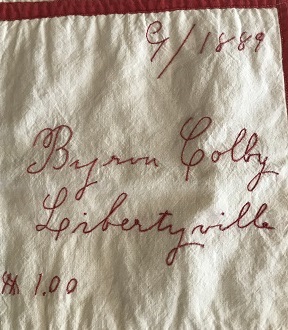 |
 |
Some squares have more detailed needlework. It makes you wonder whether the named person embroidered the square herself and added the patterns to demonstrate her needlework skills.
  |
 |
Some squares provide personal information such as in the case of Auntie Marsh who passed away the year the quilt was made or Martha French who was Age 97. (She was! I checked!) This quilt is a genealogy goldmine!
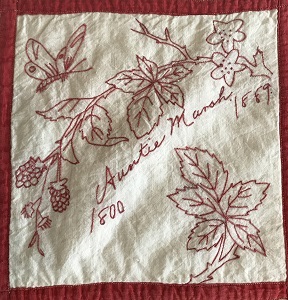 |
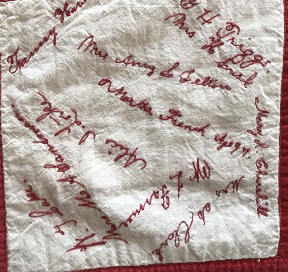 |
It’s not known for sure if there was an attempt to match a person’s actual signature. However, as evidenced on this square, there is definitely a variation in the script of the names in the Ds and Fs of Mr. and Mrs. Wheeler, the Ms of Mary Lawrence and Edna McGinnie, and the different fonts of AP and Annie Wheeler.
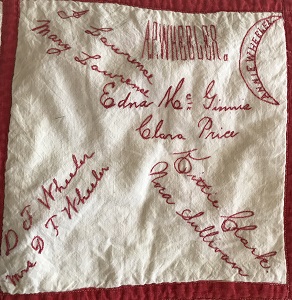
The signature on the Ansel B. Cook square is very close to his signature in the Portrait and Biographical Album of Lake County. If signatures were not being matched, the differences at least suggest that multiple people were doing the stitching.

The central square of the quilt is 18” by 18” and features a representation of the Union Church. Let’s take a closer look at the centerpiece of the quilt.
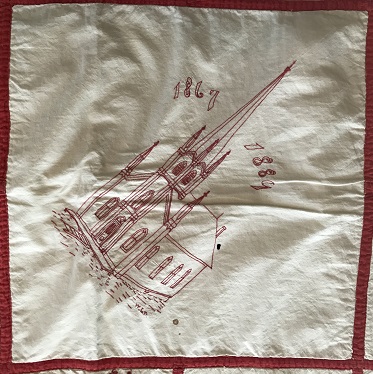
Construction of the Union Church began in 1866 on Church Street where the St. Lawrence Episcopal Church is located today.

The building was designed by architect W. W. Boyington, architect of the Chicago Water Tower and other significant Chicago area buildings. It was dedicated in late December 1868. Over its lifetime, the church was used as a meeting place for Methodist, Presbyterian, Congregational and Universalist churches. Each church had a separate hour for meeting, but the Sunday School was common to all faiths. As the individual congregations became financially able, they built their own buildings and moved out of the Union Church.
Sometime between 1881-1884, the Methodist Church erected a 25’ x 42’ frame chapel building on the land the current Methodist Church occupies on the northwest corner of Church Street and Brainerd Avenue. The chapel was intended as a place for weekday meetings but because of dissatisfaction with the use of the Union Church with other Societies, it became a place of regular worship. Methodist Church history recounts that in 1890-91 there were concerns about the condition of the chapel, and the congregation considered purchasing the Union Church, but instead decided to the build a church on the northeast corner of Milwaukee Avenue and High Street [School Street]. The new Methodist church was dedicated in 1892.

The Presbyterian Church began work on a new building on Orchard Street [East Church Street] in 1880. The building was consecrated in 1881.

This left the Congregationalists and the Universalists as the remaining regular users of the Union Church. The Universalists, who had organized in 1885, had only 25 members at the beginning and seem to have petered out by the late 1890s. In the 1890s and early 1900s, the building’s use for church services declined. During that time, the church was host to programs and performances such as “Our New England Relatives” performed by the Union Dramatic Company for the benefit of the Libertyville Union Church and the oratorio “Esther the Beautiful Queen” put on by local residents in 1896. The space was also use for Decoration Day (early Memorial Day) events and local school graduations.
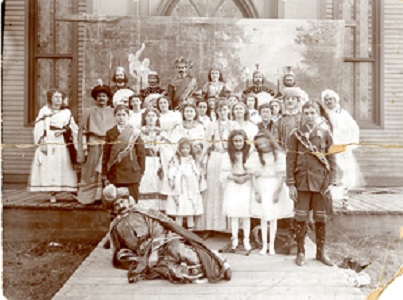
In 1912, the St. Lawrence Episcopal Church, which had started renting the Union Church in 1910, purchased the building. According to published accounts at the time, the church had been vacant for a period of several years before the Episcopals moved in. The congregation set about making improvements such as adding a center aisle which was done after the picture below was taken.

In early January 1917, a fire destroyed the Union Church building. Around 7pm on January 5, Dorothy Sayers discovered the fire en route to choir practice and the first fire alarm was received. The volunteer fire department worked hard, but could not keep up and turned their focus to dousing neighboring houses to keep the fire from spreading.
Shortly after 9pm “ the cross on the top of the steeple which stood over 110 feet from the ground crashed earthward” according to local newspaper accounts. Church members were able to save one set of vestments, a small organ, and altar furnishings, but the Union Church was lost. The St. Lawrence congregation rebuilt on the same spot and celebrated the 100th anniversary of the new building in 2017.

This is the story of the church at the heart of the quilt. Many more stories lie within the quilt’s stitches. In part 2 we will start looking at some of the individual squares and the Libertyville families, businesses, and events they represent.
Sources:
- Brackman, Barbara. Clues in the Calico: A Guide to Identifying and Dating Antique Quilts. EPM Publications, 1989.
- Cory, Pepper and McKelvey, Susan. The Signature Quilt: Traditions, Techniques and the Signature Block Collection. Quilt House Publications, 1995.
- Cozart, Dorothy. “A Century of Fundraising Quilts: 1860-1960.” Uncoverings, 1984, vol.5 , p41-54.
- Brackman, Barbara. “Signature Quilts: Nineteenth Century Trends.” Uncoverings, 1989, p.25-27.
- Cozart, Dorothy. “ The Role and Look of Fundraising Quilts 1850-1930.” In Pieced by Mother: Symposium Papers. Edited by Jeanette Lasansky. Union County Historical Society, 1988, p.87-94.
- Mason, Harold G. and Loefer, Kathleen Hubbard. Passing the Flame: The Sesquicentennial of The United Methodist Church. Libertyville, Illinois, 1836-1986.
- Williams, Claudia. “Methodist Church founded 150 years ago.” Independent Register, Sesquicentennial Section, June 1986, p.28
- Carroll, C. E. and Mason, Harold. “History and Directory of the First Methodist Church of Libertyville.” March 1958. Cook Memorial Public Library Local History File.
- “Happy Birthday to The First Presbyterian Church.” 1975. Cook Memorial Public Library Local History File.
- Dunn, Robert. “A History of the Ivanhoe Congregational Church.” Unpublished. 2011. Cook Memorial Public Library Local History File.
- Shaddle, Grace Norton and Bell, Blanche Shaddle, and Jeven, Rev. C. Arthur. “The History of the First Congregational Church of Mundelein, Illinois, 1889-1938.” Unpublished manuscript. 1938. Cook Memorial Public Library Local History File.
- Libertyville Illustrated. Chicago : Kehm, Fietsch & Miller Co. Press, 1897.
- Moore, Ed. “Community Protestant Church Celebrates 120 Years of Dedication to the Community.” The Beacon, Community Protestant Church Newsletter, April 2009, p.9.
- Lane, Arlene and Schoenfield, Sonia. “Brick church with red door has seen plenty over the years.” Mundelein Review, May 24, 2012.
- E.S.W. “St. Lawrence’s, Libertyville.” 11-15-1963.
- “St. Lawrence church grows since founding.” News Sun, July 26, 1974, p.16A
- “St. Lawrence Church, Libertyville, Illinois, Oct 17th 1910. Minutes of the Finance Committee.” Cook Memorial Public Library Local History File.
- “St. Lawrence’s Church Destroyed by Fire Friday.” Libertyville Independent, 11 Jan 1917, p.1
- “Sells Union Church.” Lake County Independent, September 20, 1912.
- “The New Church at Libertyville dedicated.” Waukegan Gazette, Jan 1869.
- Universalist Church record book. Libertyville-Mundelein Historical Society collection.
Discover more from Cook Memorial Public Library District
Subscribe to get the latest posts sent to your email.
Categories: Local History
Tags: Local History
